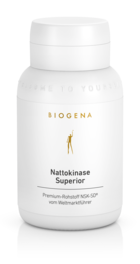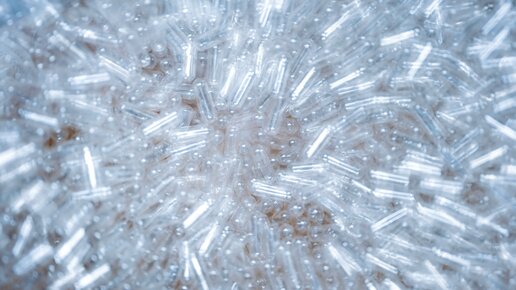Nattokinase is an enzyme that is a special feature of the Japanese soybean dish natto. Due to its blood-thinning properties and other health benefits, it has become the focus of increasing scientific attention in recent decades – attention that has brought further potential effects to light. Find out more about nattokinase, why it is so valuable for human health and what to look out for when taking it.
What is nattokinase?
Nattokinase is an enzyme that owes its name to the traditional Japanese dish Natto. This sticky, stringy delicacy is made by boiling and then fermenting soybeans. Bacillus subtilus (Japanese: Nattokin) is used as a starter culture in this refinement process, which naturally produces higher amounts of nattokinase. As a result, nattokinase and other enzymes accumulate in natto during the fermentation process.
Nattokinase – not a case of ‘nomen omen’
Contrary to what the name suggests, nattokinase does not belong to the enzyme class of kinases, but to the so-called proteases. Proteases are enzymes that break down protein molecules into smaller fragments (peptides).
The effect of nattokinase: what it is good for
Nattokinase was first described in 1987 by the Japanese researcher Hiroyuki Sumi. Due to its relatively ‘young age’, nattokinase research is still in its infancy in some areas. To save you a lot of research work, we have familiarised ourselves with the subject matter for you and summarised the most well-researched benefits and effects of nattokinase below:
The soybean dish natto in Japanese natural medicine
Natto, the source of nattokinase, is considered one of the healthiest foods in Japan and is used by naturopaths there as a remedy for cardiovascular diseases and fatigue.
Nattokinase for the prevention of cardiovascular diseases
1) Nattokinase improves blood flow. Nattokinase is often referred to as a ‘natural blood thinner’. This effect is due to its ability to break down fibrin, a protein that forms during blood clotting. This enables nattokinase not only to counteract the formation of blood clots, but also to dissolve smaller blood clots that have already formed – an important protective mechanism against cardiovascular diseases caused by blood clots (e.g. heart attacks, strokes).
Several studies, including a clinical study on 45 people, confirm that nattokinase has an influence on blood clotting not only in theory but also in practice. Supplementing with 4000 FU units of nattokinase per day for eight weeks reduced several blood clotting factors. This effect was independent of whether the subjects were healthy, suffered from cardiovascular diseases or were on dialysis. Nattokinase is therefore suitable for reducing blood clotting in various life situations.
Note: People taking anticoagulants should not take nattokinase on their own initiative or even replace their medication with it.
2) Nattokinase lowers blood pressure. High blood pressure is usually the first sign of cardiovascular disease. In the long term, this vascular hyperpressure can lead to a vicious circle, as it can also cause vascular damage.
A clinical study on 86 people showed that nattokinase can not only improve blood flow but also lower blood pressure naturally. In this study, an 8-week intake of 2000 FU units of nattokinase per day reduced both systolic (-9.1 %) and diastolic blood pressure (- 6 %).
Conclusion: Nattokinase is a natural way to strengthen your cardiovascular health and has the potential to reduce the risk of cardiovascular disease.
Nattokinase: anti-inflammatory effects under discussion
Chronic inflammation is the underlying cause of a variety of diseases. This also applies, among other things, to arteriosclerosis (= vascular calcification), in which chronic inflammatory processes occur in the vessel walls. Based on this background, researchers wondered whether and how Nattokinase can influence inflammatory processes. It was shown both in cell experiments in the laboratory and in a living model (in vivo – in a living organism) that the enzyme can inhibit certain inflammatory processes and regulate an overactivation of the immune system (the macropages).
Other studies that had focused on inflammations of the digestive system or nervous system were also able to confirm an anti-inflammatory effect of the enzyme. Nevertheless, human studies are still needed for a well-founded conclusion. It will be interesting to see what further research has to offer in this area!
Nattokinase as a dietary supplement: can it also cause side effects?
Nattokinase is generally considered to be a natural substance with few side effects. However, people who are already taking blood-thinning medication should not use nattokinase without medical advice and supervision, as this can increase the effect of the blood-thinning medication and cause unwanted side effects.
Also before surgery, including dental surgery, nattokinase should be discontinued at least one week in advance to avoid excessive bleeding during the operation.
Nattokinase used on its own is considered safe. This was also confirmed in a toxicological study from 2016, in which the tolerated dose in healthy people was even significantly higher than the currently recommended dose.
Is nattokinase found in food?
Nattokinase is mainly found in the traditional Japanese dish natto. The enzyme is practically absent from our common foods.
Nattokinase: Recommended intake
When taking nattokinase, you should ideally follow the manufacturer's recommended dosage – unless your doctor or therapist recommends otherwise.
How do you take nattokinase?
Nattokinase is best consumed with plenty of fluids. For optimal tolerability, it is recommended to take it with a meal.
When should you take nattokinase?
Nattokinase can be taken at any time of day, so you can integrate the enzyme into your daily routine in a way that suits you best.
Dosage: How much nattokinase per day?
When taking nattokinase, it is best to follow the manufacturer's recommendation. In most cases, they recommend 2.000 FU daily – a dosage that studies show is effective. However, this recommendation does NOT apply to people who take blood thinners or those who want a dosage tailored to their needs. These people should seek individualised advice from their doctor and, if necessary, determine the appropriate dosage with the help of medical expertise.
Effectiveness: How quickly does nattokinase work?
Those who take nattokinase for blood clotting can expect to see an effect relatively quickly: nattokinase begins to affect blood clotting just 2 hours after ingestion, reaching its peak after about 4 hours and starting to wear off after about 8 hours. People who want to take nattokinase for its other properties (e.g. to lower blood pressure naturally) need to be more patient and take the enzyme over a longer period of time to see results.
How long does nattokinase work?
Nattokinase should be taken regularly. Otherwise, its effect will quickly wear off.
How long can you take nattokinase?
While natto is consumed regularly in Japan, there are no studies on the safety of taking nattokinase for more than 12 months.
Capsules, tablets or powder – which is best?
Nattokinase is available to buy in a variety of forms. It is most commonly found in capsules. Tablets or powder are much less common.
Nattokinase capsules have two potential advantages over tablet variants: on the one hand, the use of capsules makes it possible to avoid unnecessary additives, while on the other hand, the use of capsules makes it possible to use gastric acid-resistant capsules to protect the nattokinase. This ensures that optimal amounts of active nattokinase reach the intestine – an advantage that also applies to powder preparations.
If you still want to take nattokinase in powder form, you should make sure that the product is as free as possible from additives and ideally comes in pre-portioned doses. This not only ensures precise dosing, but is also more hygienic.
Maximum raw material quality for maximum effect
A nattokinase product can only be as good as the raw material used to produce it. The manufacture of nattokinase requires a complex and delicate fermentation process in which the enzyme is produced by microorganisms. In this case, the use of a branded raw material is particularly suitable to ensure consistently high quality.
The brand raw material NSK-SD® is the pioneer in the field of nattokinase and is obtained by the traditional method of soybean fermentation. This guarantees that NSK-SD® corresponds to the original nattokinase that has been consumed in Japan for thousands of years. Furthermore, NSK-SD® is the first officially approved nattokinase raw material. Accordingly, numerous clinical studies are available that document the effectiveness and safety of NSK-SD®.
What does FU mean in the context of food supplements?
FU (Fibrinolytic Unit) is a unit that reflects how effectively an enzyme can break down fibrin. The higher the value, the higher the enzyme activity and thus the ability to break down fibrin.
Can you take nattokinase together with blood thinners?
As mentioned above, people taking blood thinners should never take nattokinase on their own initiative, as this combination can lead to undesirably strong blood thinning. If you are considering taking both, you should definitely seek medical advice. Experienced physicians can provide individualised advice and, if necessary, adjust the dosage of the medication and nattokinase to match. However, they should only be taken together under strict, close monitoring of blood clotting.
Take nattokinase and vitamin K2 together
Nattokinase and vitamin K2 (as MK-7) are found together in natto. Both natural substances have different effects on blood clotting: while nattokinase prevents blood clotting, vitamin K2 supports it. However, these different effects do not generally preclude their joint intake. This is because our coagulation factors only allow blood to clot when needed and do not ‘force’ it to do so.
The situation is different for people who use anticoagulants. Since both nattokinase and vitamin K2 can affect the way the medication works, medical advice is essential.
Take nattokinase and OPC together
A combination of nattokinase and oligomeric proanthocyanidins (OPC) is definitely a smart move. After all, both natural substances are beneficial for our cardiovascular system: while nattokinase improves our blood flow, lowers our blood pressure and possibly reduces inflammation in the blood vessels (more research is needed here), OPCs maintain the elasticity of the blood vessel walls and protect them from oxidative damage.
Take Ginkgo Biloba and nattokinase together
Ginkgo biloba and nattokinase are two natural substances that both have an effect on the cardiovascular system. Since their joint use has not yet been researched in detail, the combination should not be taken without consulting a doctor.
Conclusion: An insider tip in Japan for a long time, nattokinase is now also conquering the Western world. And the enzyme is very useful here! Due to its proven effects on cardiovascular health and its possible anti-inflammatory effect, nattokinase can make an important contribution to healthy aging.
Frequently asked questions about nattokinase
Nattokinase has blood-thinning and blood-pressure-lowering properties and therefore helps to prevent cardiovascular diseases. In addition, studies suggest that the enzyme also has an anti-inflammatory effect – a property that would be beneficial for a wide range of illnesses.
Nattokinase is considered to have few side effects. However, caution is advised for people who take anticoagulants. In this case, the additional intake can lead to excessive blood thinning. Nattokinase should also be discontinued at least one week before surgery to be on the safe side.
Due to a lack of study data, nattokinase should not be taken during pregnancy to be on the safe side.
No. Nattokinase is not the same as soy. Nattokinase is an enzyme that is produced by a Japanese soybean dish called natto. To produce nattokinase in natto, the soybeans are first boiled and then fermented with a special bacterial culture (Bacillus subtilus) that produces nattokinase.
No. Pregnant and breastfeeding women, children and adolescents should not take nattokinase due to a lack of study data. In addition, people who take medication – especially blood anticoagulants – should only take nattokinase under medical supervision.
Nattokinase can dissolve the blood-clotting protein fibrin, thus counteracting the formation of blood clots. In addition, nattokinase helps to lower blood pressure. For a few years now, nattokinase has also been discussed as a natural anti-inflammatory agent. However, more research is needed before any definitive conclusions can be drawn.
Sources and further studies:
(1) Weng, Y. et al. 2017. Nattokinase: An Oral Antithrombotic Agent for the Prevention of Cardiovascular Disease. Int J Mol Sci. 18(3):523. https://pubmed.ncbi.nlm.nih.gov/28264497/
(2) Fang, M. et al. 2023. Nattokinase: Insights into Biological Activity, Therapeutic Applications, and the Influence of Microbial Fermentation. Fermentation. 9(11):950. https://www.mdpi.com/2311-5637/9/11/950
(3) EFSA Panel on Dietetic Products, Nutrition and Allergies (NDA). 2016. Safety of fermented soybean extract NSK‐SD® as a novel food pursuant to Regulation (EC) No 258/97. EFSA J. 14(7):4541. https://www.efsa.europa.eu/de/efsajournal/pub/4541
(4) Ashor, A. W. et al. 2014. Effect of vitamin C on endothelial function in health and disease: A systematic review and meta-analysis of randomised controlled trials. Atherosclerosis. 235(1):9–20. https://pubmed.ncbi.nlm.nih.gov/24792921/
(5) Yang, Y. 2015. Study on the enzymatic properties of Nattokinase. Proceedings of the 5th International Conference on Information Engineering for Mechanics and Materials, Atlantis Press. https://www.atlantis-press.com/proceedings/icimm-15/25540
(6) Ero, M. P. et al. 2013. A pilot study on the serum pharmacokinetics of nattokinase in humans following a single, oral, daily dose. Altern Ther Health Med. 19(3):16–19. https://pubmed.ncbi.nlm.nih.gov/23709455/
(7) Hsia, C.-H. et al. 2009. Nattokinase decreases plasma levels of fibrinogen, factor VII, and factor VIII in human subjects. Nutr Res. 29(3):190–196. https://pubmed.ncbi.nlm.nih.gov/19358933/
(8) Kim, J. Y. et al. 2008. Effects of Nattokinase on Blood Pressure: A Randomized, Controlled Trial. Hypertens Res. 31(8):1583–1588. https://pubmed.ncbi.nlm.nih.gov/18971533/
(9) Fadl, N. et al. 2013. Serrapeptase and nattokinase intervention for relieving Alzheimer’s disease pathophysiology in rat model. Hum Exp Toxicol. 32(7):721–735. https://pubmed.ncbi.nlm.nih.gov/23821590/
(10) Wu, H. et al. 2024. Nattokinase as a functional food ingredient: therapeutic applications and mechanisms in age-related diseases. Food Sci Hum Wellness. 13(5):2401–2409. https://www.sciopen.com/article/10.26599/FSHW.2022.9250198
(11) Yan, Y. et al. 2019. Nattokinase Crude Extract Inhibits Hepatocellular Carcinoma Growth in Mice. J Microbiol Biotechnol. 29(8):1281–1287. https://pubmed.ncbi.nlm.nih.gov/31370114/
(12) Takabayashi, T. et al. 2017. Nattokinase, profibrinolytic enzyme, effectively shrinks the nasal polyp tissue and decreases viscosity of mucus. Allergol Int. 66(4):594–602. https://pubmed.ncbi.nlm.nih.gov/28389065/
(13) Tanikawa, T. et al. 2022. Degradative Effect of Nattokinase on Spike Protein of SARS-CoV-2. Molecules. 27(17):5405. https://pubmed.ncbi.nlm.nih.gov/36080170/
(14) Wu, h. et al. 2020. Breaking the vicious loop between inflammation, oxidative stress and coagulation, a novel anti-thrombus insight of nattokinase by inhibiting LPS-induced inflammation and oxidative stress. Redox Biology, Volume 32, May 2020, 101500. https://pubmed.ncbi.nlm.nih.gov/32193146/
(15) Lampe, B. J., English, J. C. 2016. Toxicological assessment of nattokinase derived from Bacillus subtilis var. natto. Food and chemical toxicology : an international journal published for the British Industrial Biological Research Association, 88, 87–99. https://pubmed.ncbi.nlm.nih.gov/26740078/
(16) Bagchi, D. et al. 2003. Molecular mechanisms of cardioprotection by a novel grape seed proanthocyanidin extract. Mutation Research/Fundamental and Molecular Mechanisms of Mutagenesis, Volumes 523–524, February–March 2003, Pages 87-97. https://pubmed.ncbi.nlm.nih.gov/12628506/
(17) Foshati, S. et al. 2022. The effect of grape (Vitis vinifera) seed extract supplementation on flow-mediated dilation, blood pressure, and heart rate: A systematic review and meta-analysis of controlled trials with duration- and dose-response analysis. Pharmacological Research, Volume 175, January 2022, 105905. https://pubmed.ncbi.nlm.nih.gov/34798267/
(18) Kurosawa, Y. et al. 2015. A single-dose of oral nattokinase potentiates thrombolysis and anti-coagulation profiles. Scientific Reports 5, Article number: 11601 (2015). https://pubmed.ncbi.nlm.nih.gov/26109079/










